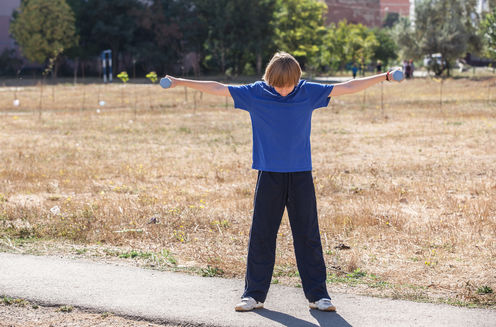
We all know exercise is an essential part of a healthy lifestyle, and most will agree kids should be doing more of it. However, a recent study found while parents are positive about their children engaging in aerobic activities (running, playing sports), they have much more negative views when it comes to strength exercises.
But these concerns are not backed up by the evidence.
People often see strength training as just lifting heavy weights in a gym, but strength training can be done in a wide variety of ways, including using just your body weight. Strength training can also incorporate medicine balls, sand bags, elastic resistance bands and weighted sleds.
Myth 1: high risk of injury
Until recent years, there was very little data on injuries associated with youth strength training. What did exist, however, were a handful of case reports outlining serious injuries from misuse of weight training equipment, and a few small studies reporting high injury rates in competitive youth weightlifting and powerlifting programs.
In 1990, the American Academy of Pediatrics cautiously recommended against participation in strength training prior to reaching physical maturity. This report was actually referring to weightlifting, powerlifting and bodybuilding, which involve the use of maximal loads and highly technical lifting movements that had never been recommended for young people.
Regardless, the message that “weights are bad for young people” took hold and the public distrust of strength training lingered on. We now know that supervised and age-appropriate strength training is a safe activity for children and adolescents, and a good way to improve muscular fitness, body composition and psychological health.
In fact, appropriately conducted strength training programs have a much lower risk of injury than many popular youth sports like soccer, football or basketball – activities that parents happily enrol their children in year after year. Ironically, participation in strength training can actually reduce the risk of children being injured when they play sports.
Myth 2: lifting weights stunts growth
You’ve probably heard at some point that strength training can stunt growth in children. This claim is based on an enduring belief that strength training causes damage to “growth plates”.
Growth plates (or epiphyseal plates) are the cartilaginous areas of growing tissue at the ends of long bones such as the femur and radius. These plates turn into hardened bone when young people reach physical maturity, but are softer during development and are therefore more susceptible to damage.
While scary to consider, growth plate injuries are actually quite common, accounting for around 15 to 30% of all bone injuries in children. Most injuries resolve completely with treatment, but on rare occasions they can result in growth abnormalities.

It’s not quite clear why strength training is considered more likely to damage growth plates than other physical activities, but this common misconception has withstood the test of time. At least part of the reason seems to be due to a misinterpretation of why elite athletes in sports like weightlifting and gymnastics are consistently short.
Long story short (pun intended), small athletes are better suited to these sports, in the same way that being tall is an advantage in basketball. Therefore, short athletes are more highly represented at the upper levels of competition, where we tend to notice them. This has nothing to do with high volumes of training or lifting heavy weights. While strength training often gets the blame, the truth is growth-plate injuries occur much more often during organised sports.
Extensive research on the safety of youth strength training programs has found no evidence to suggest they have adverse effects on growth, nor is there any evidence that strength training during the growing years impacts final adult height.
Do children and teenagers need strength training?
The World Health Organisation, American Academy of Pediatrics and the Australian government all agree muscle-strengthening physical activities are important for the health and well-being of young people. In fact, government guidelines explicitly recommend young people (aged five to 18 years) participate in muscle- and bone-strengthening activities at least three days a week.
These recommendations are based on a large body of evidence demonstrating the unique benefits of strength training. In a review of prior research, we found stronger kids have a healthier heart, lower body fat, stronger bones and higher self-esteem.
Importantly, the evidence seems to suggest the healthiest youngsters will be those who participate in a variety of activities, targeting not just the heart and lungs, but also the muscles, joints and bones.
So children and adolescents can and should “lift weights”, as long as it’s done properly. Experts recommend beginners start with body weight exercises and add weight only when they are competent at the movements. If using external weights, training should be supervised by a qualified instructor. Exercises should be matched to the age and experience level of the individual.
Maximal lifts before reaching physical maturity (usually around 16 years) are still not recommended. The focus during childhood and early adolescence should be on developing movement skills and building strength endurance (the ability for muscles to work repeatedly). This will provide the right foundation for improving maximal strength in later years, when individuals have the competence, confidence and experience to perform the lifts safely.
Simple and effective body weight exercises young people can start with include push-ups, squats, lunges, planks (holding body horizontal to the ground, with weight resting on your hands/forearms and toes to strengthen the core), bear crawls (crawling on hands and feet to work out the whole body), mountain climbers (in plank position, bring one knee at a time up to your chest to strengthen core) and the superman (lie flat on stomach with arms extended overhead and lift arms and legs off the floor to strengthen lower back).
Jordan Smith does not work for, consult, own shares in or receive funding from any company or organization that would benefit from this article, and has disclosed no relevant affiliations beyond the academic appointment above.
